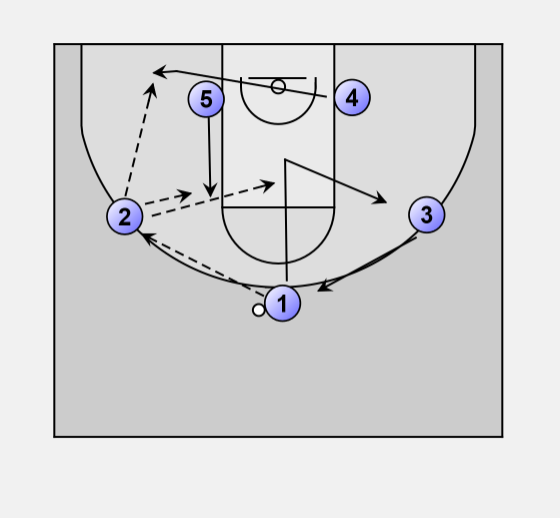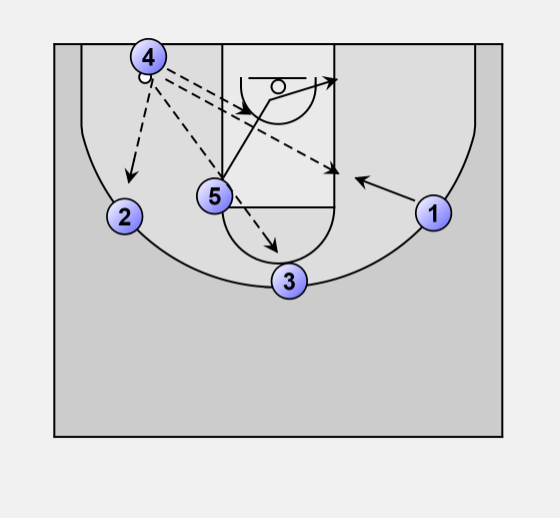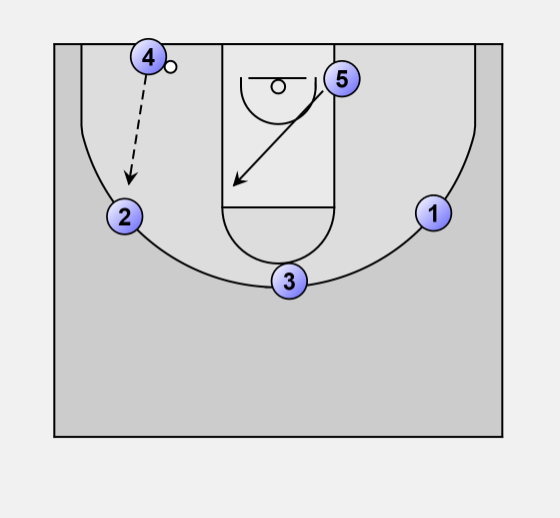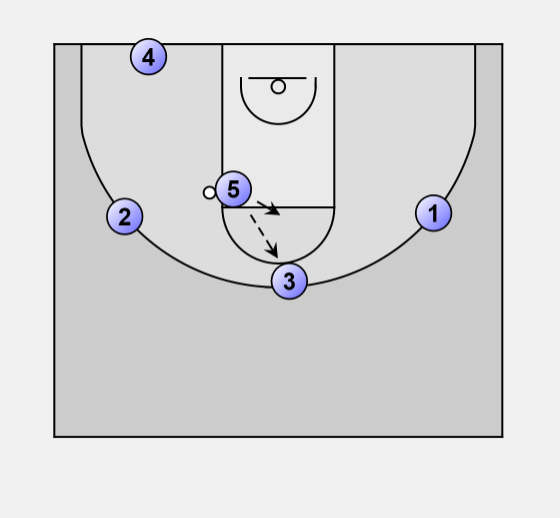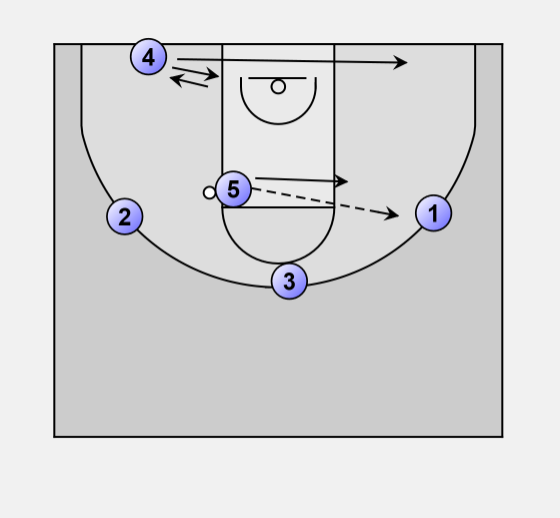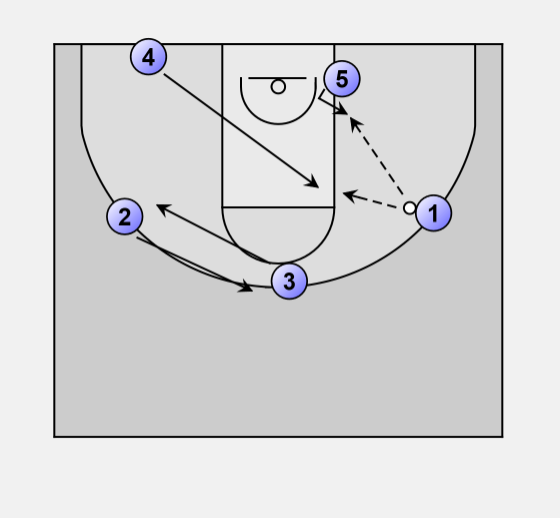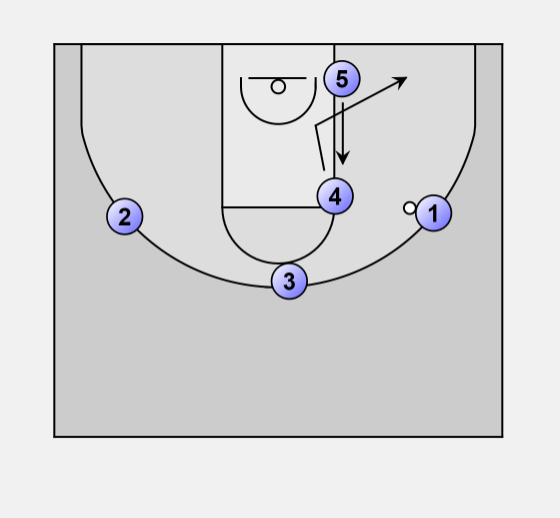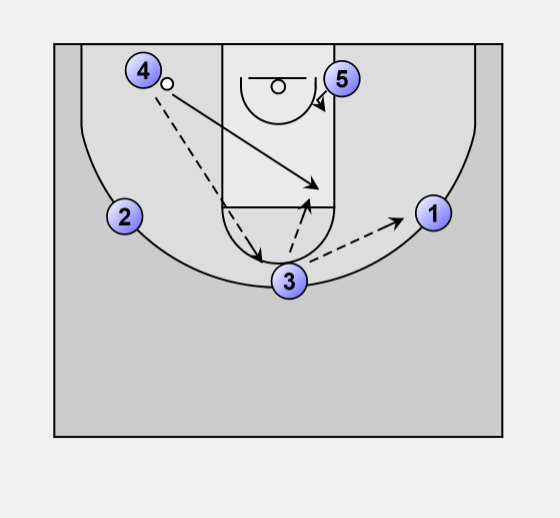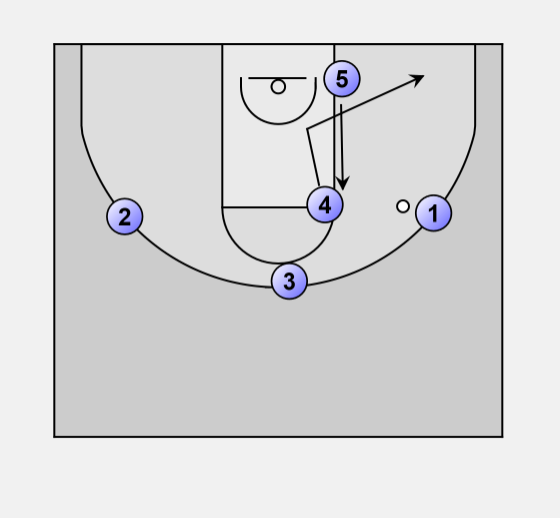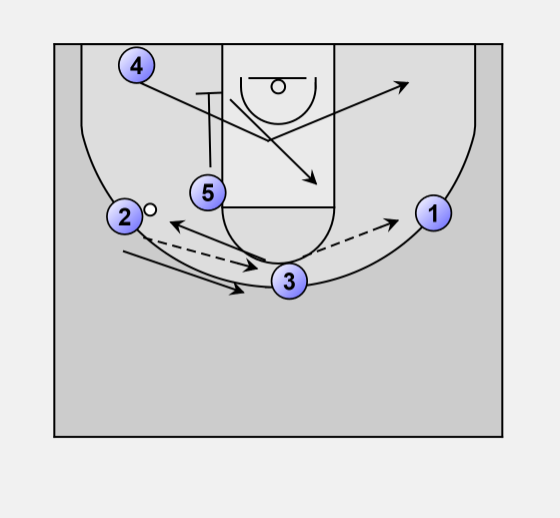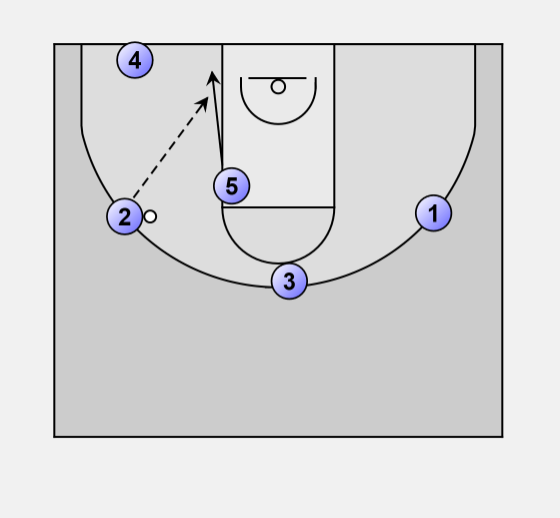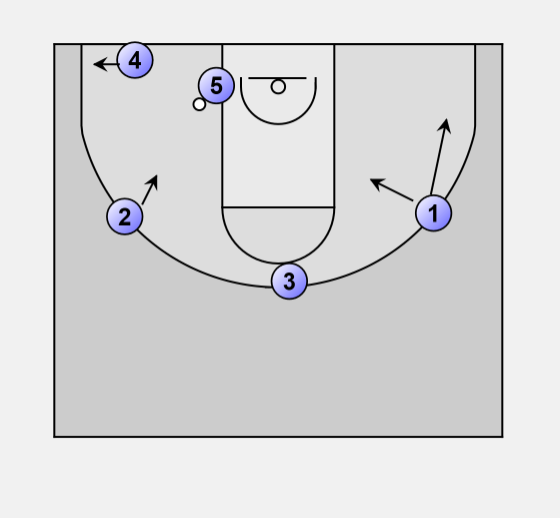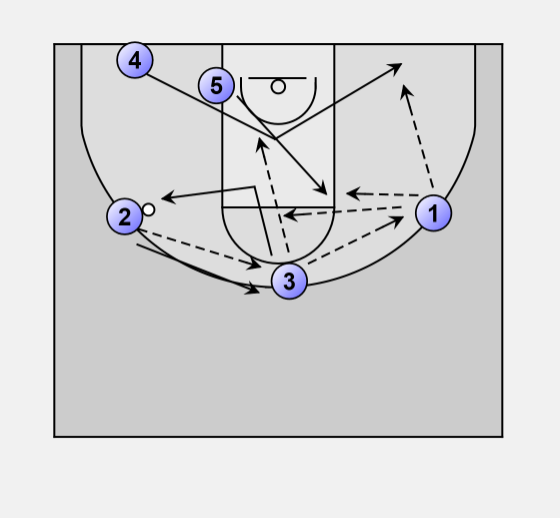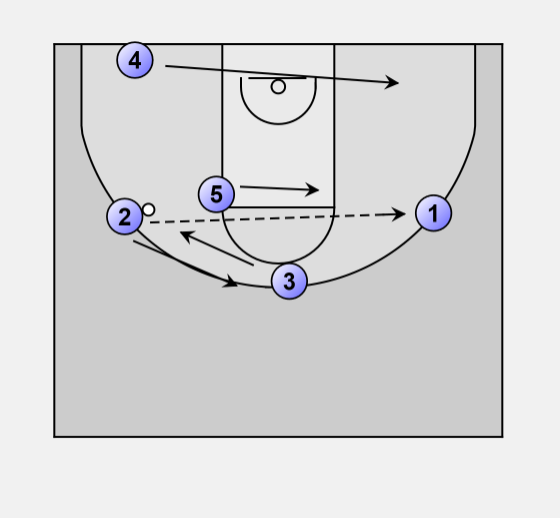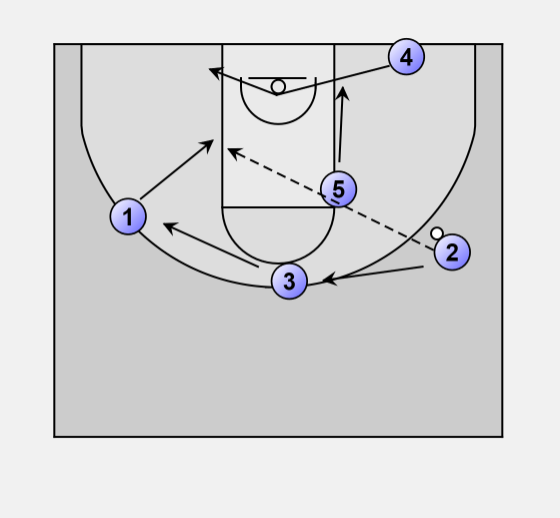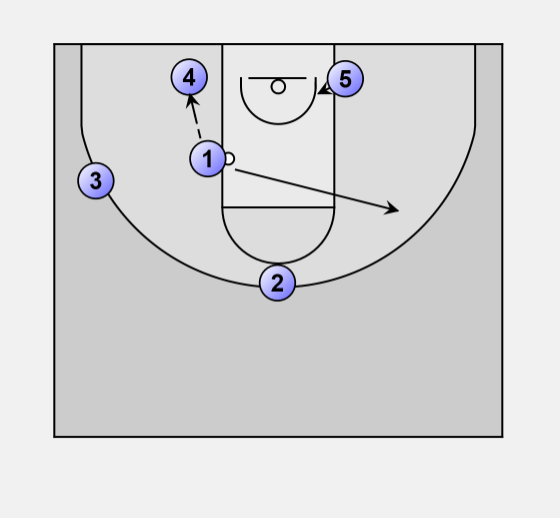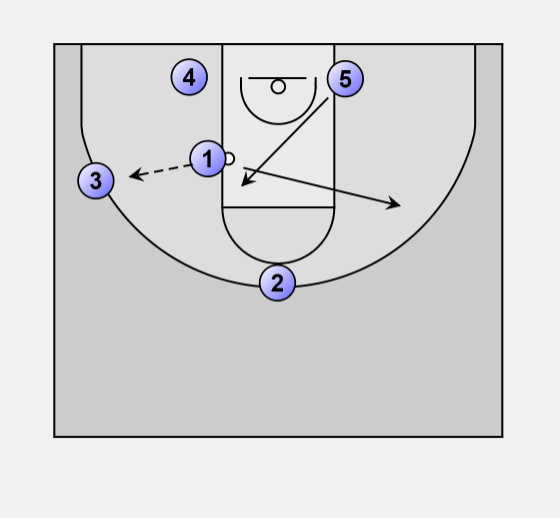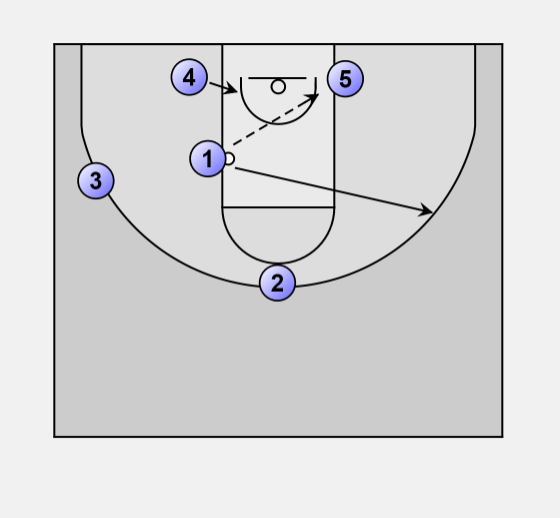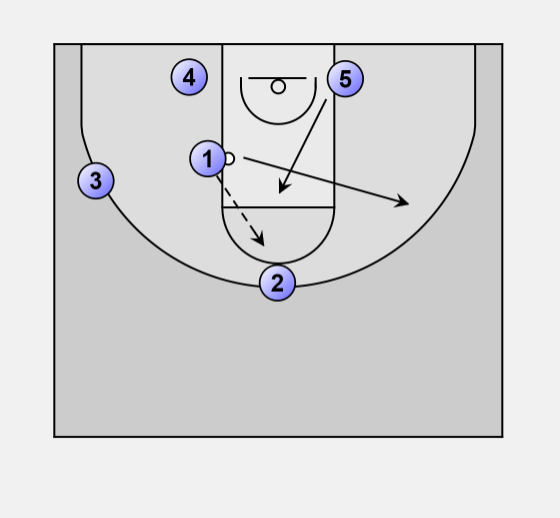This is a zone offense with a 3 out 2 in set. (4) will always be in the short corner and (5) will be on the low blocks or the elbow. (1), (2), and (3) will rotate on the outside.
(1) will pass to either wing, in this case (2), and flash the middle of the lane for a pass from (2). (1) will clear to the opposite wing. (3) will replace (1) on the point.
(5), after (1) clears, will move to the elbow on the ball side. (4) will move to the short corner ball side.
(2) can pass to (4) or (5). (4) can play low/high with (5). (5) can play high/low with (4).
This play can be run to either side. If the ball had gone to (3), (5) would have made a diagonal cut to the ball side elbow.

Assume the pass went to (4). (5) will cut to the basket and then the attack side low block.
(1) will step in on the attack side.
(4) has pass options to (5), (2), (3), or (1). (4) can shoot, or attack on the baseline.

If (4) passes to (2), (5) will return to the elbow, in effect, replacing himself.

Assume (2) passed to (5) at the elbow, either when he first receive the pass from (1) or when he receives a return pass from (4).
If (5) passes to (4), he will cut down the lane and to the opposite low block. This is the same move as when (2) passes to (4).
If (5) passes to (3), (5) will "point" to the ball and move to the elbow on the ball side depending on where (3) passes.

If (5) passes to (1), he will follow the pass to the ball side elbow. (4) will run to the ball side short corner.
This is the same motion as (2) skip passing to (1).
When (5) has the ball at the elbow, (4) has the option of cutting in and returning to the short corner or cutting to the opposite short corner. This will be based on a read by (4) of possible openings in the zone.
If (4) returns, (5) has all of the same options. If (4) cuts through, (5)'s options will be 1) hitting (4), 2) skip passing to (1) so the play can be run to the other side. The last options will be to pass to (3) or (2).

Assuming (4) passed to (1) on the attack side. (5) will attempt to seal his man on the low block for a pass from (1). (4) will follow his pass to (1) to the elbow. (2) and (3) will exchange on the point and wing.
(1) has option to (5) or (4).

If (4) and (5) are not open, (5) will come to the ball side elbow and (4) will cut to the ball side short corner.
The play is now ready to run to the other side.

If (4) passes to (3), he will move to the ball side elbow. (5) will attempt to seal his man on the low block. (3) can hit (4) on the elbow or pass to (1) on the wing.
If (4) receives the pass, he will look for the shot or play high/low with (5). He has escape options to (1), (3) or (2).

If the ball is passed to (1), from either (3) or (4), (5) will come to the elbow and (4) will cut inside (5) down the lane and then to the short corner.

If (2) cannot pass to (4) or (5), he can reverse the ball to (3). (5) will set a down screen for (4). (4) will curl into the lane, looking for a pass from (3) or (1) and then move to the short corner.
After the pass to (1), (2) and (3) will exchange.

The reversal of the ball can be signaled by (5) diving to the ball side low block. (2) can attempt to hit (5).

Assuming the ball goes to (5), (4) will step out for a pass. (2) and (1) will relocate to open areas.
(5) has the same pass options when he is at the elbow with the same motion rules.

If (2) does not pass to (5), (2) will pass to (3). At the same time, (4) will flash through the lane looking for a pass from (3). If (4) does not receive a pass, he will move to the opposite short corner.
(3) will reverse the ball to (1). (5) will follow (4)'s cut and move to the elbow. (1) will have options to (3) on the cut, (4), and (5).
(3) and (2) will exchange. (3) will read (5)'s movement to determine the depth of his cut.
The play is now ready to be run to the other side.

If (2) skip passes to (1), (5) will cut to the ball side elbow and (4) will cut to the ball side short corner. The play will be ready to run to the other side.
(3) and (2) will exchange.

This motion shows the setup after the initial pass to a wing and the exchange between the point and attack side wing.
If (1) attacks the backside of the zone and receives a pass from (2), (4) will move across the lane to the opposite low block or short corner. (5) will move to the low block on the side he is on.
The point and wing will rotate, replacing the attack side wing.
The attack side wing, (1) in this case, has options to the other four players. (1) can also shoot or drive to the basket. The other players must be aware of the possible penetration by (1).

If (1) passes to (4), (1) will clear to the attack side wing. (5) will duck into the lane for a possible pass.
(4) can shoot, drive, or pass to (5). If these options are not open, (4) can pass to any of the perimeter players and start the basic Eagle motion.

If (1) passes to (3) on the wing, (1) will clear to the attack side wing and (5) will move to the elbow. This puts the players in position to run the basic Eagle motion.

If (1) passes to (5), (1) will move to the ball side wing and (4) will attempt to duck into the lane.
(5) can pass to any of the other four players and the basic Eagle motion can begin.

If (1) passes to the point, (1) will move to the open wing and (5) will point the ball. (2) can pass to any player and the basic Eagle motion can begin.

Submitted by: Mark Bradley and Gary Schulte
Category: Offense zone
